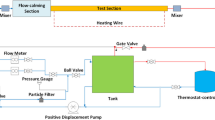Abstract
The surface heat flux measurement is challenging in numerous engineering applications such as aerospace engineering, internal combustion engines, advanced manufacturing processes is challenging due to rapid change in flow conditions. The coaxial thermocouples (CTs) have the response time in the range of milliseconds or less and they can capture the heating rate in impulsive ground-based conditions. The K, E, and J-type coaxial thermocouples were used to measure surface heat flux over a flat plat at different angles of attack 0°, 15°, 30°, and 45° exposing them into a convective based flow environment. The numerical analysis was performed by using software package Ansys-fluent for the experimental conditions to validate the experimental results. It has been noticed that, the average errors between experimental and numerical results are found in the range of ± 0.3% and ± 2.5% for transient temperature and surface heat flux respectively. This investigation is analogous to aerodynamics heating facilities and the results are confirmed that these in-house fabricated coaxial thermocouples are capable to measure surface heat flux at different location of the aerodynamic vehicles.










Similar content being viewed by others
Abbreviations
- AOA:
-
Angle of attack (°)
- c:
-
Specific heat (Jkg−1 K−1)
- k:
-
Thermal conductivity (Wm−1 K−1)
- \(q_{{\rm{s}}}\) :
-
Surface heat flux (Wm−2)
- t:
-
Time(s)
- T:
-
Temperature (K)
- S:
-
Sensitivity (µVK−1)
- \(T_{{\rm{s}}} \left( t \right)\) :
-
Temperature function of time (K)
- ρ :
-
Density (kgm−3)
- β :
-
Effective thermal product (Jm−2 s−0.5 K−1)
- τ :
-
Dummy time variable (s)
- \(\alpha_{0}\) :
-
Thermal coefficient of resistance (K−1)
- V :
-
Velocity (ms−1)
- P :
-
Pressure (kgm−1 s−2
References
Li J, Chen H, Zhang S, Zhang X, Yu H. On the response of coaxial surface thermocouples for transient aerodynamic heating measurements. Exp Thermal Fluid Sci. 2017;86:141–8.
Tunay T, Sahin B, Ozbolat V. Effects of rear slant angles on the flow characteristics of Ahmed body. Exp Thermal Fluid Sci. 2014;57:165–6.
Marr MA, Wallace JS, Chandra S, Pershin L, Mostaghimi J. A fast response thermocouple for internal combustion engine surface temperature measurements. Exp Thermal Fluid Sci. 2010;34(2):183–9.
Sahoo N, Kumar R. Performance assessment of thermal sensors during short-duration convective surface heating measurements. Heat Mass Transf. 2016;52(9):2005–13.
Manjhi SK, Kumar R. Comparative performance of K, E, and J-type fast response coaxial probes for short-period transient measurements. J Therm Sci Eng Appl. 2021;13:3.
Werschmoeller D, Li X, Ehmann K. Measurement of transient tool-internal temperature fields during hard turning by insert-embedded thin film sensors. J Manuf Sci Eng. 2012;134:6.
Sahoo N, Peetala RK. Transient temperature data analysis for a supersonic flight test. J Heat Transfer. 2010;132:8.
Saravanan S, Jagadeesh G, Reddy KP. Convective heat-transfer rate distributions over a missile shaped body flying at hypersonic speeds. Exp Thermal Fluid Sci. 2009;33(4):782–90.
Gai SL, Mudford NR. Stagnation point heat flux in hypersonic high enthalpy flow. Shock Waves. 1992;2(1):43–7.
Jagadeesh G, Reddy NM, Nagashetty K, Reddy KP. Forebody convective hypersonic heat transfer measurements over large-angle blunt cones. J Spacecr Rocket. 2000;37(1):137–9.
Kumar R, Sahoo N. Dynamic calibration of a coaxial thermocouples for short duration transient measurements. journal of heat transfer. 2013;135(12).
Sarma S, Sahoo N, Unal A. Calibration of a silver thin film gauge for short duration convective step heat load. Sādhanā. 2016;41(7):787–4.
Reddy NM, Nagashetty K, Jagadeesh G, Reddy KP. Review of hypersonic research investigations in IISc shock tunnel (HST1). Sadhana. 1996;21(6):741–73.
Agarwal S, Sahoo N, Singh RK. Experimental techniques for thermal product determination of coaxial surface junction thermocouples during short duration transient measurements. Int J Heat Mass Transf. 2016;103:327–35.
Bendersky D. A special thermocouple for measuring transient temperatures. Mech Eng. 1953;75(2):117.
Kovacs A, Mesler RB. Making and testing small surface thermocouples for fast response. Rev Sci Instrum. 1964;35(4):485–8.
Buttsworth DR. Assessment of effective thermal product of surface junction thermocouples on millisecond and microsecond time scales. Exp Thermal Fluid Sci. 2001;25(6):409–20.
Mohammed H, Salleh H, Yusoff MZ. Design and fabrication of coaxial surface junction thermocouples for transient heat transfer measurements. Int Commun Heat Mass Transfer. 2008;35(7):853–9.
Ozalp N, JayaKrishna D. CFD analysis on the influence of helical carving in a vortex flow solar reactor. Int J Hydrogen Energy. 2010;35(12):6248–60.
Schultz DL, Jones TV. Heat-transfer measurements in short-duration hypersonic facilities. Advisory Group For Aerospace Research And Development Neuilly-Sur-Seine Neuilly-Sur-Seine; 1973: AGARD-AG-165, University of Oxford.
Taler J. Theory of transient experimental techniques for surface heat transfer. Int J Heat Mass Transf. 1996;39(17):3733–48.
Db RJ. A practical guide to splines. Math Comput. 1980;34(149):325.
Kline SJ. Describing uncertainty in single sample experiments. Mech Eng. 1953;75:3–8.
Moffat RJ. Describing the uncertainties in experimental results. Exp Thermal Fluid Sci. 1988;1(1):3–17.
Moffat RJ. Using uncertainty analysis in planning of an experiment. ASME J Fluids Eng. 1985;107:173–8.
Author information
Authors and Affiliations
Corresponding author
Additional information
Publisher's Note
Springer Nature remains neutral with regard to jurisdictional claims in published maps and institutional affiliations.
Rights and permissions
About this article
Cite this article
manjhi, S.K., Kumar, R. Assessments of surface heat flux from rapid temperature sensors at various angles of attack over a plate. J Therm Anal Calorim 147, 11493–11506 (2022). https://doi.org/10.1007/s10973-022-11341-4
Received:
Accepted:
Published:
Issue Date:
DOI: https://doi.org/10.1007/s10973-022-11341-4




